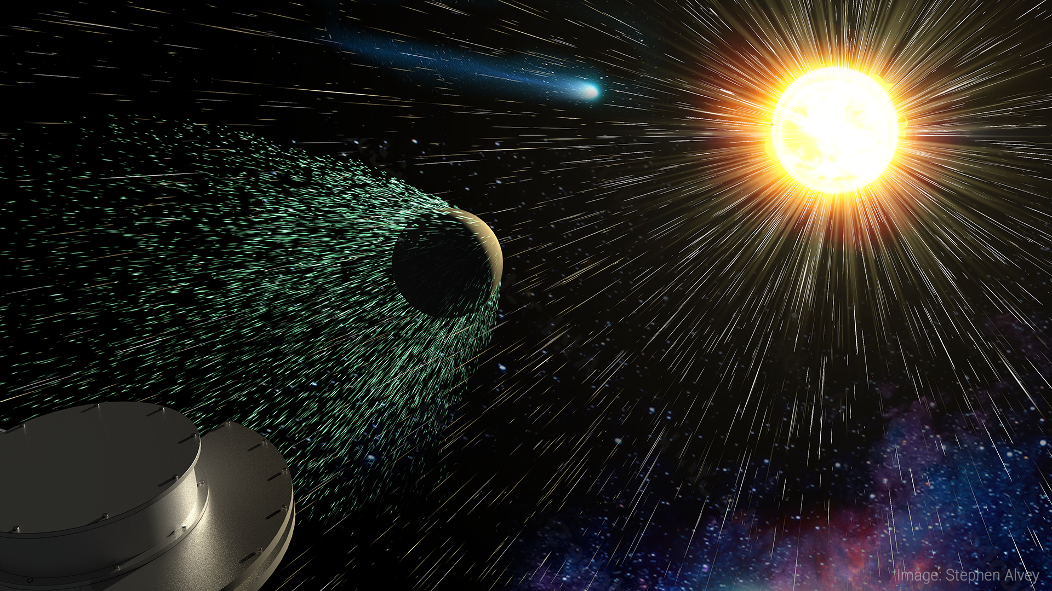PROJECT:
Solar Wind Pickup Ion Composition Energy Spectrometer (SPICES)
SNAPSHOT:
SPICES is a new sensor that will help scientists discover where matter originates and how it is energized throughout the solar system
Imagine that you have a secret decoder ring that you can use to decipher a secret message with important clues about things around you: where they came from, why they are there, and what will become of them in the future. Now imagine that the secret decoder ring is actually a sensor that can be flown in space to unravel secrets about the matter in the solar system. Where did this matter originate, how did it become energized, and how could it impact humans living on Earth and traveling in space? SPICES is like a decoder ring for the plasma (gas consisting of electrically charged particles) in the solar system. It has the potential to reveal important information about how the Sun behaves and interacts with planets and their atmospheres, and how the solar system is impacted by its own motion through interstellar space.
The universe is mostly made of hydrogen, but the elements that make up life as well as the planets, comets, and many other celestial bodies are heavier than hydrogen. In fact, these heavier elements, although not as abundant, can hold the key to understanding how numerous processes in the universe work. In our solar system, these “heavy elements”—which are called “heavy ions” when they are electrically charged—can help us trace plasma to its origin at planets, comets, the Sun and solar atmosphere, and even to interstellar space.
Heavy ions are an important piece of the puzzle that describes how the solar system supports and sustains life. They also play a role in large eruptions on the Sun that cause solar storms. For example, solar flares that emit vast amounts of X-rays are mostly due to excitation of heavy ions on the Sun. Being able to predict and prepare for solar storms is important to keep humans and robotics safe on space missions. SPICES will enable us to better understand how these solar storms form by giving scientists information about how eruptions on the Sun occur and how they accelerate plasma. With this information, scientists can better predict when and how severe solar storms will be.
SPICES is designed to measure the chemical makeup of electrically charged streams of particles (also called wind) that blow in space. SPICES will measure the solar wind—the wind that blows away from the Sun, including the wind that results from the most severe solar storms. It will also measure neutral wind that blows into the solar system from interstellar space and becomes charged as it encounters the Sun, and wind that blows off planetary surfaces and out of planetary atmospheres. Measuring the chemical composition of these streams of particles can help us understand how the solar system was created, its behavior today, and how it will behave in the future.
SPICES is optimized to detect less common heavy ions—like low-charge ions and isotopes—that are not well measured by current spaceborne sensors. The SPICES design incorporates a novel and state-of-the-art method of boosting the energy of incoming ions so that their fingerprints can be more clearly identified, allowing the abundance and variability of these rare species to be accurately measured. Some of these rarer species are only found inside solar storms and can change how these storms interact with Earth’s space environment.
But boosting the energy of these incoming ions is challenging; it must be done safely, without putting the SPICES electronics or other instruments at risk, and without heating the sensor up too much. The methods used on SPICES to boost the ion energy are based on traditional methods, but the new design can boost the ion energy 60% higher than prior space sensors by stepping up the energy one stage at a time to reach the maximum level desired. The design also incorporates a protective bubble to shield electronics and other onboard systems from the high energy ions generated by SPICES. SPICES will soon be ready to fly on upcoming missions that study the global behavior of the Sun, planetary atmospheres, monitor space weather, or fly out to the edges of the solar system into interstellar space.
This engineering challenge is being tackled by engineers at the University of Michigan Space Physics Research Laboratory, with contributions from Southwest Research Institute in Texas. The sensor's original design was a result of collaboration of scientists at the University of Michigan including Dr. George Gloeckler, one of the pioneers of space-based ion mass spectrometers; Professor Susan Lepri; Dr. Jason Gilbert; and Associate Professor Jim Raines.
PROJECT LEAD:
Professor Susan Lepri, The University of Michigan
SPONSORING ORGANIZATION
Heliophysics Strategic Technology Office (HESTO)




























